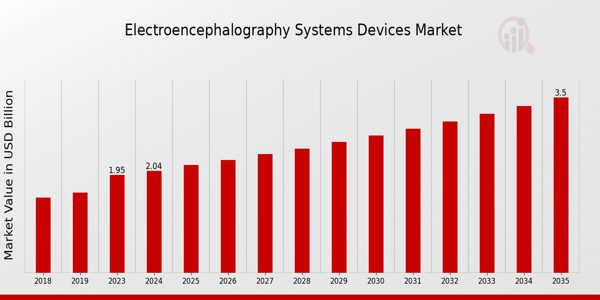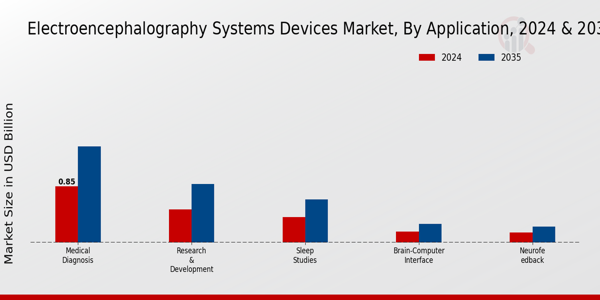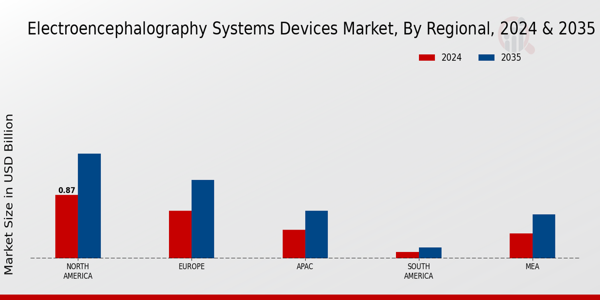Electroencephalography Systems Devices Market Overview
As per MRFR analysis, the Electroencephalography Systems Devices Market Size was estimated at 1.95 (USD Billion) in 2023. The Electroencephalography Systems Devices Market Industry is expected to grow from 2.04(USD Billion) in 2024 to 3.5 (USD Billion) by 2035. The Electroencephalography Systems Devices Market CAGR (growth rate) is expected to be around 5.01% during the forecast period (2025 - 2035).
Key Electroencephalography Systems Devices Market Trends Highlighted
The Global Electroencephalography Systems Devices Market is shaped by several key market drivers that include the rising prevalence of neurological disorders such as epilepsy and sleep disorders. Increased focus on early diagnosis and treatment of these conditions is prompting demand for advanced EEG devices. Technological advancements, including portable and wireless EEG systems, are enhancing patient monitoring and making the devices more user-friendly. The growing geriatric population, which is more susceptible to neurological issues, further adds to the market's expansion. Opportunities remain abundant within this market, particularly in emerging economies where healthcare infrastructure is rapidly developing.
The increasing adoption of telemedicine and remote patient monitoring systems presents a chance for innovative EEG solutions that can cater to remote areas. Partnerships between medical device companies and research institutions could lead to the development of cutting-edge EEG technologies tailored to specific medical conditions. Additionally, the integration of EEG devices with artificial intelligence is set to open new avenues for comprehensive data analysis and diagnosis, enhancing clinical decision-making.
Recent times have seen trends towards a greater emphasis on minimizing patient discomfort during EEG procedures, with the introduction of less invasive techniques and streamlined processes.Technological innovations have also led to more compact and portable devices, improving ease of use in both clinical and home settings. The focus is increasingly on user-friendly interfaces and real-time data analysis to improve response times in critical situations. Overall, the market is evolving to meet patient needs and improve clinical outcomes.

Source: Primary Research, Secondary Research, MRFR Database and Analyst Review
Electroencephalography Systems Devices Market Drivers
Increasing Prevalence of Neurological Disorders
The growth of the population and other reasons have led to the increased prevalence of neurological disorders like Parkinson’s, epilepsy, and Alzheimer’s. That is why the global market for diagnosing and managing these disorders using electroencephalography systems is expected to grow at a rapid pace. The Electroencephalography Systems Devices Market Industry is just starting to witness heightened demand, but it will grow rapidly. With increased awareness of the importance of early interventions, more demand for effective diagnostic tools will arise.
Healthcare providers are expanding the use of EEG devices due to their crucial role in diagnosing sleep related issues as well as monitoring brain activity during surgeries. The introduction of wireless and more portable devices is also driving the market. Furthermore, there is a strong concentration on the designing of new EEG devices because of ongoing research initiatives that will improve the accuracy, functionality, and usability of the devices.
These dynamics will definitely increase the reliance and application of EEG systems in both clinical and home environments. As a whole, the continuously increasing range of the global population suffering from issues and diseases pertaining to the brain will help energize the growth of the Global Electro. The global market for electroencephalography systems devices will always be driven higher with the increased population of patients suffering from neurological systems.
Technological Advancements in EEG Systems
Technological innovations are playing a pivotal role in enhancing the functionality and applications of electroencephalography systems. The Global Electroencephalography Systems Devices Market Industry is benefiting from advancements in hardware and software, allowing for real-time data analysis and improved patient monitoring capabilities. Enhanced connectivity features, such as cloud-based systems that enable remote access to EEG data, are transforming how healthcare providers interact with EEG devices.Furthermore, the development of high-density EEG systems and the use of artificial intelligence in data interpretation are opening new avenues for accurate diagnosis and treatment planning, driving the market forward.
Growing Demand for Homecare Monitoring Solutions
With the increasing emphasis on home healthcare and chronic disease management, there is a rising demand for portable EEG devices that facilitate home monitoring. Patients and caregivers are seeking solutions that enable brain activity tracking from the comfort of home. The Global Electroencephalography Systems Devices Market Industry is responding to this need by introducing more convenient and accessible EEG systems that do not compromise quality.This trend is not only empowering patients with self-management capabilities but also easing the burden on healthcare facilities, contributing to the market's growth.
Electroencephalography Systems Devices Market Segment Insights
Electroencephalography Systems Devices Market Application Insights
The Global Electroencephalography Systems Devices Market has been witnessing notable growth, particularly in the Application segment, which plays a crucial role in various healthcare and research domains. In 2024, the market within this segment is valued at approximately 2.04 USD Billion and is projected to grow significantly by 2035. A major contributor to this growth is the Medical Diagnosis application, which was valued at 0.85 USD Billion in 2024 and expected to rise to 1.45 USD Billion by 2035. This application dominates the overall segment due to the increasing prevalence of neurological disorders and the growing need for accurate diagnostic tools, which are central to patient care in the healthcare industry.Following closely is the Research Development application, valued at 0.5 USD Billion in 2024, projected to increase to 0.88 USD Billion by 2035.
This area fosters innovation in neuroscience and technology, serving as a crucial foundation for advancements in understanding brain functions and disorders. The Sleep Studies application is also significant, initially valued at 0.38 USD Billion in 2024, with an expectation to grow to 0.65 USD Billion by 2035. The rising awareness about sleep-related issues and their impact on overall health has augmented the demand for EEG devices in clinical sleep research, emphasizing its importance in a population increasingly focused on mental and physical well-being.In contrast, Brain-Computer Interface applications, valued at 0.16 USD Billion in 2024 and projected to reach 0.28 USD Billion by 2035, hold promise for enhancing communication for individuals with mobility impairments, although currently, this area accounts for a smaller share of the overall market due to its specialized nature and ongoing research requirements.
Similarly, the Neurofeedback application, seeing a valuation of 0.15 USD Billion in 2024 with an expected rise to 0.24 USD Billion by 2035, illustrates a niche but growing segment where EEG devices are utilized for self-regulation of brain activity, often in therapeutic settings.While Medical Diagnosis and Research Development applications dominate the market, the continuous evolution of EEG technology and its diverse applications open up opportunities for significant growth across the board. The overall market trends suggest an increasing investment in health technologies and an overall drive towards innovation, addressing both diagnostic and therapeutic needs aligned with rising health consciousness among consumers. As the Global Electroencephalography Systems Devices Market revenue continues to expand, the essential role of these applications becomes more pronounced, supported by robust Global Electroencephalography Systems Devices Market data that highlight the segmentation dynamics and industry potential.

Source: Primary Research, Secondary Research, MRFR Database and Analyst Review
Electroencephalography Systems Devices Market Product Type Insights
The Global Electroencephalography Systems Devices Market is experiencing notable growth, with an expected valuation of 2.04 billion USD by 2024. Within this broader market, the Product Type segment is crucial, encompassing various types of EEG devices that serve distinctive functions and applications. Portable EEG Devices are gaining traction due to their convenience and ability to facilitate real-time monitoring and catering, especially to patients requiring home-based care. Standalone EEG Systems remain essential in clinical settings, providing comprehensive cranial assessments and diagnostics.
Meanwhile, Brainwave Monitoring Systems are playing a vital role in advanced research applications and mental health assessments, helping to track brain activity in various contexts. Wireless EEG Systems are also emerging as a significant component, offering enhanced mobility and user-friendliness, which are key for both clinical and personal use. The combination of these devices contributes to the overall Global Electroencephalography Systems Devices Market revenue and illustrates a diverse landscape with unique opportunities and challenges, ultimately reflecting the evolving demands of healthcare technology and patient care.As these types continue to evolve, staying ahead of trends, such as technological advancements and user demands, will be essential for stakeholders within the market.
Electroencephalography Systems Devices Market End User Insights
The Global Electroencephalography Systems Devices Market is witnessing significant growth, particularly in the End User segment, which includes diverse categories such as hospitals, academic institutions, research laboratories, and home care settings. In 2024, the overall market is expected to be valued at 2.04 billion USD, contributing to the increasing utilization of electroencephalography systems in these environments. Hospitals dominate this segment due to their essential role in diagnosing neurological disorders, while academic institutions focus on research and training, contributing to advancements in EEG technology.Research laboratories play a crucial role in exploratory studies, thereby driving innovation within the market.
Home care settings are becoming increasingly significant, catering to patients who require continuous monitoring outside traditional healthcare facilities, thus promoting accessibility to EEG assessments. The demand across these categories is fueled by rising neurological disorders, technological advancement, and an increasing focus on early diagnosis, positioning these end users as key players in shaping the Global Electroencephalography Systems Devices Market industry.The market growth is also supported by favorable regulatory frameworks and increased awareness about brain health among the population.
Electroencephalography Systems Devices Market Technology Insights
The Global Electroencephalography Systems Devices Market is expected to reach a valuation of 2.04 billion USD by 2024, growing steadily due to technological advancements in neuromonitoring. Within the Technology segment, devices leveraging Wet Electrodes have historically held a majority, owing to their established efficacy in delivering precise readings through the conductive gel, which enhances signal quality. Meanwhile, Dry Electrodes are gaining traction due to their ease of use and portability, making them suitable for a range of applications, from clinical settings to at-home monitoring.
The adoption of Active and Passive Electrodes also plays a crucial role; Active Electrodes boast built-in amplification for clearer signals, appealing to researchers and clinicians alike. Conversely, Passive Electrodes benefit from a simpler structure and lower costs, providing a budget-friendly option while still serving fundamental roles in EEG studies. The diverse functionalities and applications of these electrode types cater to varying needs within the Global Electroencephalography Systems Devices Market, contributing to its overall growth and efficiency as it adapts to the expanding demand for neurological assessments and related studies.
Electroencephalography Systems Devices Market Regional Insights
The Global Electroencephalography Systems Devices Market is experiencing notable growth across regional segments. In 2024, North America holds a significant market value of 0.87 USD Billion, expected to increase to 1.43 USD Billion by 2035, reflecting its dominance in the industry due to advanced healthcare infrastructure and innovative technologies. Europe follows closely, with a market valuation of 0.65 USD Billion in 2024 and reaching 1.07 USD Billion in 2035, driven by strong research initiatives and increasing neurological disorders.
The APAC region, valued at 0.39 USD Billion in 2024 and projected to grow to 0.65 USD Billion by 2035, highlights emerging opportunities due to rising healthcare investments and improving access to medical devices.In South America, the market starts at 0.09 USD Billion in 2024 and grows to 0.15 USD Billion by 2035, indicating a gradual increase in demand, while the MEA region shows a market value of 0.34 USD Billion in 2024, expected to reach 0.6 USD Billion by 2035, reflecting ongoing healthcare advancements. Overall, these insights into the Global Electroencephalography Systems Devices Market segmentation reveal the competitive landscape and growth drivers, underscoring the importance of regional dynamics in shaping the market's future.

Source: Primary Research, Secondary Research, MRFR Database and Analyst Review
Electroencephalography Systems Devices Market Key Players and Competitive Insights :
The Global Electroencephalography Systems Devices Market is characterized by a dynamic landscape driven by increasing demand for diagnostic tools in neurology and mental health. The market has witnessed significant advancements in technology, with an emphasis on enhancing the precision and usability of EEG devices. Competitive insights into this market reveal a blend of established players and emerging newcomers vying for market share through innovation and strategic collaborations. These companies are continuously striving to improve user experience by integrating cutting-edge features that allow for better data acquisition and analysis.
Furthermore, regulatory changes and rising awareness about neurological disorders are propelling the market forward, making it increasingly competitive as entities work to differentiate their offerings and capture diverse client segments.Cadwell Industries has carved a niche for itself within the Global Electroencephalography Systems Devices Market, primarily due to its reputation for high-quality, reliable products tailored for clinical and research applications. The company is known for its commitment to innovation and customer service, which sets it apart from competitors. Its strong portfolio includes advanced EEG systems that integrate seamless data management capabilities, thus enhancing the overall diagnostic experience.
Cadwell Industries leverages its extensive experience in the field to provide comprehensive solutions that address complex neurological conditions. The brand's established presence in the market is reinforced by strong customer relationships and a focus on delivering specialized training and support, providing a solid foundation for growth and operational success.Compumedics has emerged as a formidable player in the Global Electroencephalography Systems Devices Market with its innovative approaches and technology-driven solutions. The company stands out through its commitment to research and development, ensuring that its EEG systems feature the latest advancements in neuroscience.
Compumedics places significant emphasis on high-quality data acquisition and analysis tools, which are essential for both clinical and research settings. The efficiency and accuracy of its systems have led to increased adoption in hospitals and healthcare environments globally. By focusing on enhancing user interfaces and data interpretative tools, Compumedics has not only improved the functionality of its products but has also enriched the overall user experience, thereby maintaining a stronghold in a competitive market landscape.
Key Companies in the Electroencephalography Systems Devices Market Include:
- Cadwell Industries
- Compumedics
- BrainScope
- NeuroSky
- Thought Technology
- Nihon Kohden
- Emotiv
- Siemens
- Micromed
- Philips
- GE Healthcare
- Medtronic
- eVox
- Advanced Brain Monitoring
Electroencephalography Systems Devices Market Industry Developments
The Global Electroencephalography Systems Devices Market has seen significant activity recently, with innovations and advancements in technology being at the forefront. Companies like Nihon Kohden and Philips are introducing advanced EEG systems that enhance data accuracy and provide improved patient monitoring capabilities. Cadwell Industries and Compumedics are focusing on expanding their product ranges to cater to increasing demand in both clinical and research settings. Notably, BrainScope and Emotiv have attracted attention for their efforts to integrate AI into EEG monitoring, which could revolutionize neurological assessments.
Current market valuations for firms like GE Healthcare and Medtronic reflect sustained growth supported by technological advancements and a rising prevalence of neurological disorders globally. Furthermore, notable mergers and acquisitions are shaping the landscape; for instance, Advanced Brain Monitoring's recent collaborative venture with a tech startup aims to bolster its EEG product offerings. As competition intensifies, companies are investing heavily in RD to enhance their market positions. The overall competitive environment suggests a proactive approach among key players to innovate and expand, reflecting a robust outlook for the market.
Electroencephalography Systems Devices Market Segmentation Insights
Electroencephalography Systems Devices Market Application Outlook
- Medical Diagnosis
- Research Development
- Sleep Studies
- Brain-Computer Interface
- Neurofeedback
Electroencephalography Systems Devices Market Product Type Outlook
- Portable EEG Devices
- Standalone EEG Systems
- Brainwave Monitoring Systems
- Wireless EEG Systems
Electroencephalography Systems Devices Market End User Outlook
- Hospitals
- Academic Institutions
- Research Laboratories
- Home Care Settings
Electroencephalography Systems Devices Market Technology Outlook
- Wet Electrodes
- Dry Electrodes
- Active Electrodes
- Passive Electrodes
Electroencephalography Systems Devices Market Regional Outlook
- North America
- Europe
- South America
- Asia Pacific
- Middle East and Africa
Scope:
| Attribute/Metric Source: |
Details |
| MARKET SIZE 2023 |
1.95(USD Billion) |
| MARKET SIZE 2024 |
2.04(USD Billion) |
| MARKET SIZE 2035 |
3.5(USD Billion) |
| COMPOUND ANNUAL GROWTH RATE (CAGR) |
5.01% (2025 - 2035) |
| REPORT COVERAGE |
Revenue Forecast, Competitive Landscape, Growth Factors, and Trends |
| BASE YEAR |
2024 |
| MARKET FORECAST PERIOD |
2025 - 2035 |
| HISTORICAL DATA |
2019 - 2024 |
| MARKET FORECAST UNITS |
USD Billion |
| KEY COMPANIES PROFILED |
Cadwell Industries, Compumedics, BrainScope, NeuroSky, Thought Technology, Nihon Kohden, Emotiv, Siemens, Micromed, Philips, GE Healthcare, Medtronic, eVox, Advanced Brain Monitoring |
| SEGMENTS COVERED |
Application, Product Type, End User, Technology, Regional |
| KEY MARKET OPPORTUNITIES |
Rising prevalence of neurological disorders, Increasing demand for home-based monitoring, Advancements in wireless EEG technology, Integration with artificial intelligence, Growing awareness of mental health issues |
| KEY MARKET DYNAMICS |
increasing prevalence of neurological disorders, technological advancements in EEG devices, growing demand for personalized medicine, rising awareness and education, expanding applications in research and diagnostics |
| COUNTRIES COVERED |
North America, Europe, APAC, South America, MEA |
Frequently Asked Questions (FAQ) :
The Global Electroencephalography Systems Devices Market is expected to be valued at 2.04 USD Billion in 2024.
By 2035, the market is anticipated to reach a value of 3.5 USD Billion.
The market is expected to grow at a CAGR of 5.01% from 2025 to 2035.
North America is expected to hold the largest market share valued at 0.87 USD Billion in 2024.
The European market is projected to be valued at 1.07 USD Billion by 2035.
The market value for Medical Diagnosis applications is estimated at 0.85 USD Billion in 2024.
Some major players include Cadwell Industries, Compumedics, BrainScope, and Siemens among others.
The market for Sleep Studies applications is expected to reach 0.65 USD Billion by 2035.
The APAC region's market is expected to be valued at 0.65 USD Billion in 2035.
The market value for Neurofeedback applications is estimated at 0.15 USD Billion in 2024 and is expected to grow to 0.24 USD Billion by 2035.
















